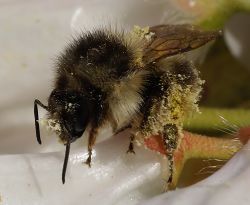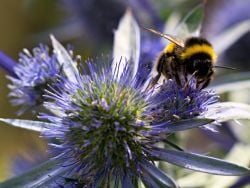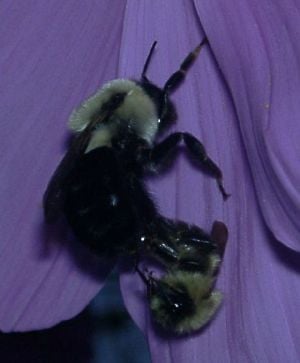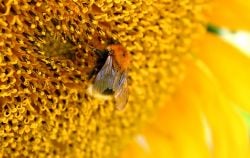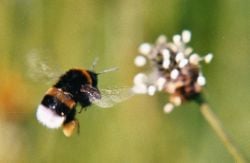| Bombus | ||||||||||||||||
|---|---|---|---|---|---|---|---|---|---|---|---|---|---|---|---|---|
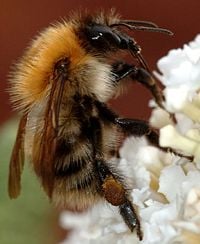 | ||||||||||||||||
| Scientific classification | ||||||||||||||||
| ||||||||||||||||
|
more than 250 species and subspecies in 37 subgenera |
Bumblebee (also spelled bumble bee, sometimes known as humblebee) is any member of the flying insect genus Bombus in tribe Bombini and family Apidae. Traditionally, and in some current taxonomic schemes, Psithyrus, the taxon of parasitic bumblebees, has been recognized as a separate genus of bumblebees within Bombini; however, most authors now list Psithyrus as a subgenus within Bombus.
As a bee (members of the superfamily Apoidea of the order Hymenoptera), bumblebees are characterized by sucking and chewing mouthparts, large hind feet, and hair-like extensions on the head and thorax. Bumbleebees tend to be larger and more visibly furry than other types of bee. They typically are characterized by black and yellow body "hairs," often in bands, a commonality among the majority of the species of Bombus; however, some species are known to have orange or even red on their bodies, or may be entirely black (NHM 2007b). The soft nature of the long, branched setae (the hair-like extensions, called pile) that covers their entire body makes them appear and feel fuzzy.
Like almost all extant (living) species of bees, and like their close relatives the honeybees, bumblebees subsist on nectar and pollen, with nectar serving as a carbohydrate and energy source and pollen as a source of protein and other nutrients. Most pollen is used as food for their young. Species of the subgenus Psithyrus are all believed to be obligate social parasites in colonies of other Bombus species (NHM 2007).
Most bumblebees are important pollinators of flowering plants. As they advance their survival and reproduction through collection of pollen and nectar, they also provide a value to the plants, serving as insect vectors of pollination. Bumblebees also provide important values to human beings, being used as pollinators for agricultural crops (notably tomatoes), and prized for their beauty. Bumblebees generally are very gentle, and not inclined to sting. But their various striped colors and buzzing sound adds to human enjoyment of nature.
Overview and description
There are about 250 separate species in Bombus (NHM 2007c). However, the variable color patterns within species has helped to contribute to some taxonomic confusion,with more than 2800 names having been used, including diverse species names and synonyms (NHM 2007c). Today, most bumblebees are placed in a single genus, Bombus (Williams 1991; Rasmont and Adamski 1995). Nonetheless, for a long time Psithyrus was recognized as a separate genus, both because of their distinctive morphology and because of their distinctive behavior as social parasites in colonies of the other Bombini (NHM 2007a). However, most studies indicate that while Psithyrus is monophyletic, as is the collective group of Bombini, when the remaining bumblebees are treated by themselves, minus Psithyrus, they are a paraphyletic grouping (NHM 2007a). Thus, Williams (1991) recommended Psithyrus as a subgenus and Bombus as the genus for all bumblebees, which is accepted by most recent authors (NHM 2007a).
.
Bumblebees tend to be robust and furry (hairy). The color patterns often are highly variable within species, but closely similar among species within the same geographical region‚ÄĒthat is, different species tend to have similar patters if in the same geographic area (NHM 2007b).
Bumblebees are social insects. Many are eusocial in a manner quite similar to the eusocial Vespidae, such as hornets. The queen initiates a nest on her own (unlike queens of honeybees and stingless bees, which start nests via swarms in the company of a large worker force). Bumblebee colonies typically have from 50 to 200 bees at peak population, which occurs in mid to late summer. Nest architecture is simple, limited by the size of the nest cavity (pre-existing), and colonies are rarely perennial. Bumblebee queens sometimes seek winter safety in honeybee hives, where they are sometimes found dead in the spring by beekeepers, presumably stung to death by the honeybees. It is unknown whether any survive winter in such an environment.
Members of the Psithyrus are cleptoparasitic (discussed below). Whereas most bumbleebees have queens, workers, and drones, Psithyrus species lack workers. Females of Psithyrus can be distinguished from other bumblebee females by the rear legs, which are not adapted for pollen collection (Pickering 2002). Instead, they rely on workers of other Bombus species after parasitizing their nests.
Queen and worker bumblebees sting, but typically do so only in self-defense or if their nest is disturbed. The sting is not barbed like that of the honey bee, so they can sting more than once. Female cuckoo bumblebees will aggressively attack host colony members, and sting the host queen, but will ignore other animals (including humans) unless disturbed.
Bumblebees are common in Asia, Europe, North America, Central America, and South America. Bumblebees are typically found in higher latitudes and/or high altitudes, though exceptions exist (there are a few lowland tropical species). A few species (Bombus polaris and B. arcticus) range into very cold climates where other bees might not be found. One reason for this is that bumblebees can regulate their body temperature, via solar radiation, internal mechanisms of "shivering," and radiative cooling from the abdomen (called heterothermy). Other bees have similar physiology, but it has been best studied in bumblebees (Heinrich 1993).
Food
Bumblebees extract nectar from a flower using their long tongue ("glossa") and store it in their crop. Some species (e.g., B. occidentalis and B. affinis) of bumblebee also exhibit what is known as "nectar robbing": instead of inserting the mouthparts into the flower normally, these bees bite directly through the base of the corolla to extract nectar, avoiding pollen transfer. These bees obtain pollen from other species of flowers that they "legitimately" visit.
Pollen is removed from flowers deliberately or incidentally by bumblebees. Incidental removal occurs when bumblebees come in contact with the anthers of a flower while collecting nectar. The bumblebee's body hairs receive a dusting of pollen from the anthers, which is then groomed into the corbiculae ("pollen baskets").
Once they have collected nectar and pollen, bumblebees return to the nest and deposit the harvested nectar and pollen into brood cells, or into wax cells for storage. Unlike honeybees, bumblebees only store a few days' worth of food and so are much more vulnerable to food shortages. However, because bumblebees are much more opportunistic feeders than honeybees, these shortages may have less profound effects. Nectar is stored essentially in the form it was collected, rather than being processed into honey as is done in honeybees; it is therefore very dilute and watery, and is rarely consumed by humans.
The parasitic Psithyrus do not collect pollen, and instead lay their eggs in nests of other Bombus species, where they are raised by the other species.
Life cycle
Bumblebees form colonies. However, their colonies are usually much less extensive than those of honeybees, because of the small physical size of the nest cavity, the fact that a single female is responsible for the initial construction, and the restriction to a single season (in most species). Often, mature bumblebee nests will hold fewer than 50 individuals, and may be within tunnels in the ground made by other animals, or in tussock grass. Bumblebees mostly do not preserve their nests through the winter, though some tropical species live in their nests for several years (and their colonies can grow quite large, depending on the size of the nest cavity). The last generation of summer includes a number of queens who overwinter separately in protected spots. The queens can live up to one year, possibly longer in tropical species.
Bumblebees, like other members of Hymenoptera, have a unique genetic system, haplodiploidy, whereby mated females control the sex of their eggs, with daughters developing from fertilized eggs and sons from unfertilized eggs (Pickering 2002). Unmated females can produce only sons.
In temperate zone species, in the autumn, young queens ("gynes") mate with males (drones) and diapause during the winter in a sheltered area, whether in the ground or in a man-made structure. In the early spring, the queen comes out of diapause and finds a suitable place to create her colony, and then builds wax cells in which to lay her fertilized eggs from the previous winter. The eggs that hatch develop into female workers, and in time the queen populates the colony, with workers feeding the young and performing other duties similar to honey bee workers. New reproductives are produced in autumn, and the queen and workers die, as do the males.
"Cuckoo" bumblebees
Bumblebees of the subgenus Psithyrus (known as cuckoo bumblebees, and formerly considered a separate genus) are a lineage that has lost the ability to collect pollen, and are instead cleptoparasitic in the colonies of other bumblebees. Before finding and invading a host colony, a Psithyrus female (there is no caste system in these species) will feed directly from flowers. Once she has infiltrated a host colony, the Psithyrus female will kill or subdue the queen of that colony and forcibly (using pheromones and/or physical attacks) "enslave" the workers of that colony to feed her and her young.
Importance
Bumblebees are important pollinators of both crops and wildflowers.
Bumblebees are increasingly cultured for agricultural use as pollinators because they can pollinate plant species that other pollinators cannot by using a technique known as buzz pollination. For example, bumblebee colonies are often used in greenhouse tomato production, because the frequency of buzzing that a bumblebee exhibits effectively releases tomato pollen.
The agricultural use of bumblebees is limited to pollination. Because bumblebees do not overwinter the entire colony, they are not obliged to stockpile honey, and are therefore not useful as honey producers.
Bumblebees are in danger in many developed countries due to habitat destruction and collateral pesticide damage. In Britain, until relatively recently, 19 species of native true bumblebee were recognized along with six species of cuckoo bumblebees. Of these, three have already become extinct (UNT 2006; Harman 2003), eight are in serious decline and only six remain widespread (numerous species of bumblebees live in Narberth, Pembrokeshire, which is known as the "bumblebee capital of all Wales"). A decline in bumblebee numbers could cause large-scale sweeping changes to the countryside, due to inadequate pollination of certain plants.
Bumblebee myths
Flight
According to twentieth century folklore, the laws of aerodynamics prove that the bumblebee should be incapable of flight, as it does not have the capacity (in terms of wing size or beat per second) to achieve flight with the degree of wing loading necessary. Jokingly, not being aware of scientists proving it cannot fly, the bumblebee succeeds under "the power of its own arrogance." The origin of this myth has been difficult to pin down with any certainty. John McMasters (1989) recounted an anecdote about an unnamed Swiss aerodynamicist at a dinner party who performed some rough calculations and concluded, presumably in jest, that according to the equations, bumblebees cannot fly. In later years McMasters has backed away from this origin, suggesting that there could be multiple sources, and that the earliest he has found was a reference in the 1934 French book Le vol des insectes by M. Magnan. Magnan is reported to have written that he and a Mr. Saint-Lague had applied the equations of air resistance to insects and found that their flight was impossible, but that "One shouldn't be surprised that the results of the calculations don't square with reality" (Ingram 2000).
Buzz
One common, yet incorrect, assumption is that the buzzing sound of bees is caused by the beating of their wings. The sound is the result of the bee vibrating its flight muscles, and this can be done while the muscles are decoupled from the wings, a feature known in bees, but not possessed by other insects. This is especially pronounced in bumblebees, as they must warm up their bodies considerably to get airborne at low ambient temperatures (Heinrich 1993). This is how bumblebees can sometimes reach an internal thoracic temperature of 30 degrees centigrade.
ReferencesISBN links support NWE through referral fees
- Harman, A. 2003. Bumblebee shortage. Bee Culture 59(July).
- Heinrich, B. 1993. The Hot-Blooded Insects: Strategies and Mechanisms of Thermoregulation. Springer. ISBN 978-3540563020
- Ingram, J. 2000. The Barmaid's Brain and Other Strange Tales from Science. New York: W. H. Freeman. ISBN 0716741202
- Macdonald, M., and G. Nisbet, G. 2006. Highland Bumblebees: Distribution, Ecology and Conservation. Inverness: Highland Biological Recording Group. ISBN 0955221102
- McMasters, J. H. 1989. The flight of the bumblebee and related myths of entomological engineering. American Scientist 77 (March/April): 146-169.
- Michener, C. D. 2000. The Bees of the World. Baltimore, MD: Johns Hopkins University Press. ISBN 0801861330
- Natural History Museum (NHM). 2007a. Bombus: Psithyrus. Natural History Museum, London. Retrieved January 27, 2017.
- Natural History Museum (NHM). 2007b Bombus: Find species by color pattern. Natural History Museum, London. Retrieved January 27, 2017.
- Natural History Museum (NHM). 2007c Bombus: Introduction. Natural History Museum, London. Retrieved January 27, 2017.
- Pickering, J. 2002. Bombus. Discover Life. Retrieved January 27, 2017.
- Rasmont, P., and A. Adamski. 1995. Les bourdons de la Corse (Hymenoptera, Apoidea, Bombinae). Notes Fauniques de Gembloux 31: 3-87.
- University of Newcastle upon Tyne (UNT). 2006. Scientists map the flight of the bumblebee. Science Daily. Retrieved January 27, 2017.
- Williams, P. H. 1991. The bumble bees of the Kashimir Himalaya (Hymenoptera: Apidae, Bombini). Bulletin of the British Museum 60(1)204.
External links
All links retrieved November 22, 2023.
Credits
New World Encyclopedia writers and editors rewrote and completed the Wikipedia article in accordance with New World Encyclopedia standards. This article abides by terms of the Creative Commons CC-by-sa 3.0 License (CC-by-sa), which may be used and disseminated with proper attribution. Credit is due under the terms of this license that can reference both the New World Encyclopedia contributors and the selfless volunteer contributors of the Wikimedia Foundation. To cite this article click here for a list of acceptable citing formats.The history of earlier contributions by wikipedians is accessible to researchers here:
The history of this article since it was imported to New World Encyclopedia:
Note: Some restrictions may apply to use of individual images which are separately licensed.
